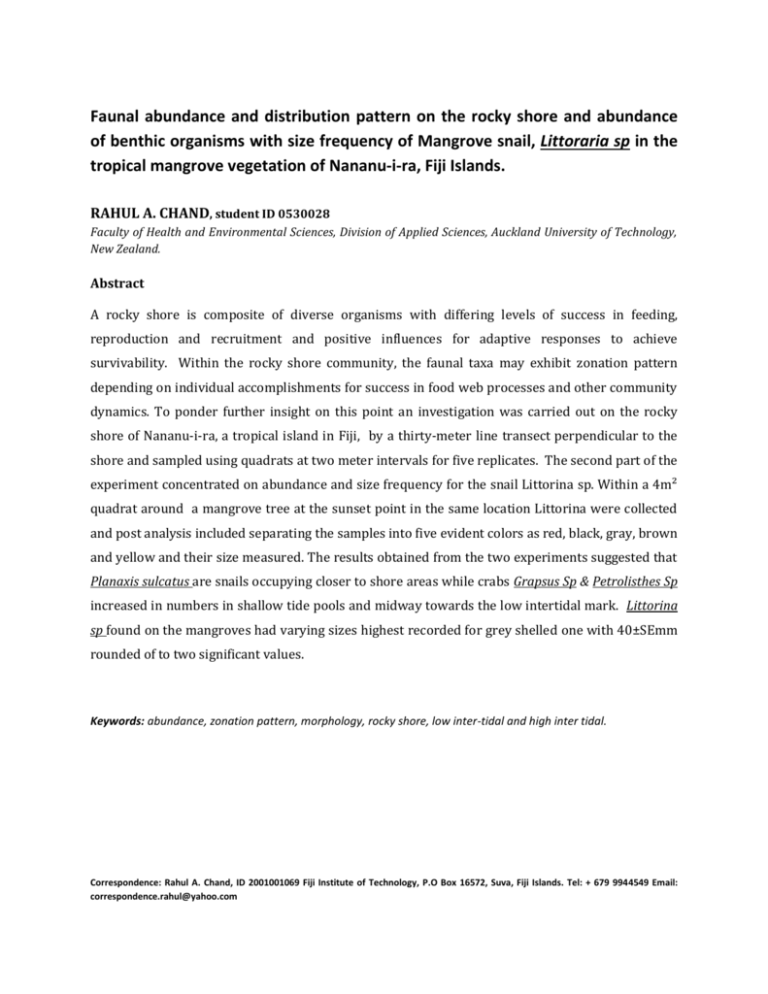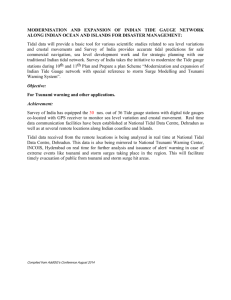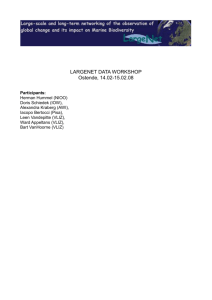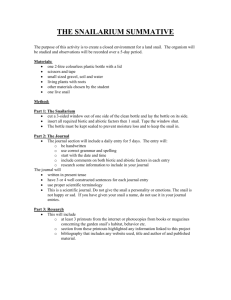Faunal abundance and distribution pattern on the rocky shore and
advertisement

Faunal abundance and distribution pattern on the rocky shore and abundance of benthic organisms with size frequency of Mangrove snail, Littoraria sp in the tropical mangrove vegetation of Nananu-i-ra, Fiji Islands. RAHUL A. CHAND, student ID 0530028 Faculty of Health and Environmental Sciences, Division of Applied Sciences, Auckland University of Technology, New Zealand. Abstract A rocky shore is composite of diverse organisms with differing levels of success in feeding, reproduction and recruitment and positive influences for adaptive responses to achieve survivability. Within the rocky shore community, the faunal taxa may exhibit zonation pattern depending on individual accomplishments for success in food web processes and other community dynamics. To ponder further insight on this point an investigation was carried out on the rocky shore of Nananu-i-ra, a tropical island in Fiji, by a thirty-meter line transect perpendicular to the shore and sampled using quadrats at two meter intervals for five replicates. The second part of the experiment concentrated on abundance and size frequency for the snail Littorina sp. Within a 4m² quadrat around a mangrove tree at the sunset point in the same location Littorina were collected and post analysis included separating the samples into five evident colors as red, black, gray, brown and yellow and their size measured. The results obtained from the two experiments suggested that Planaxis sulcatus are snails occupying closer to shore areas while crabs Grapsus Sp & Petrolisthes Sp increased in numbers in shallow tide pools and midway towards the low intertidal mark. Littorina sp found on the mangroves had varying sizes highest recorded for grey shelled one with 40±SEmm rounded of to two significant values. Keywords: abundance, zonation pattern, morphology, rocky shore, low inter-tidal and high inter tidal. Correspondence: Rahul A. Chand, ID 2001001069 Fiji Institute of Technology, P.O Box 16572, Suva, Fiji Islands. Tel: + 679 9944549 Email: correspondence.rahul@yahoo.com 1.0 Introduction 1.1 Experimental design, literature available and food web processes. The ecology of animals and plants on intertidal rocky shores has been a topic of interest for decades in many parts of the world. There have long been descriptions of fauna and flora (Underwood, 2000) (Colman, 1933; Fischer-Piette, 1936) and some manipulative experimentation goes back at least to the 1930s (Hatton, 1932).In addition to that mangroves are seen to be a very important source of food, habitat and form a important aspect of benthic and pelagic food webs within the marine ecosystem (cited Kieckbusch et al, 2004). Nananu-i-ra island has a rich biodiversity of marine flora and fauna and has some marine ecological studies carried out on snail migration in the mangrove vegetation ( Alfaro 2008) however very little data is available about rocky shores zonation pattern and abundance of species along the coast. Nananu-i-ra has mangrove vegetation populated with snails ( Alfaro, 2008) and a lot other species composition is still left to be found out as little data is available for study. The unique characteristics of the mangroves in this island is that most of the vegetation is lying just above the rocky plates (shores) with good adaptation for survival. Littorina sp. snail are active grazers on epilithic micro-algae (Alfaro, 2007) confirmed by other experiments on the same species in King George Island, Antarctica ( Iken , 1999) and in Hong Kong by Mark & Williams , 1999. When collecting data for zonation pattern for typically migratory species such as the crabs (Nishimoto, 1980) and conchs either bury in the inter- or sub tidal mud (Caldwell, 1959) or, like the blue crabs, move offshore (Gunter & Menzel, 1957) or those that may actively move with tide for feeding and reproduction the best method suggested is mark and recapture ( such as used by Chapman & Underwood, 1994)however on time constraints for short experiment like this a simple experimental design with line transect and quadrat method with errors accounted for suits well. Quantitative studies of abundance in mangroves included semiquantitative quadrat technique ( Reid ,1985)through out the Indo West Pacific and nested sampling design by Lee and Williams, 2002a in Hong Kong. 1.2 Rocky shore species composition and zonation pattern It is worth a small amount of space on a reprise of why rocky intertidal habitats have been at the forefront of development of ecological experimentation. Most notably, a rocky intertidal shore encompasses a gradient of environmental conditions from fully marine below low tidal levels to terrestrial where splash and spray reach to the highest levels above high tide. Mostly, although not always, the gradient occurs over a small (meters to tens of meters) distance making some patterns of response to environmental variables relatively easy to see (Newell, 1976). On such gradients, there is usually a great variety of animals and plants, often having several representatives in functional groups or guilds (Menge et al., 1986). These animals could be predatory whelks, crabs, grazing snails, seaweeds and other organisms that are macroscopic, highly moving, sessile or migratory (cited from Underwood and Chapman, 1996 and Connell, 1972). In order to understand the relationships, feeding patterns and behavior (reviews by Branch, 1984; Underwood, 1986a, 1992a), and growth and reproduction this study in part took a look at the abundance of species and zonation pattern of the rocky shore of Nananu-i-ra island; thus one of the aims of the experiment. 1.3 Mangrove snails Littorina sp are a common snail taxa found on tropical mangroves forests well situated to feed and avoid tidal immersion thus actively involving migration from benthic environment to leaves and branches of the tree. (Cited from Alfaro, 2007 and Gallagher and Reid, 1979). Many studies tend to focus on distribution (Reid 1985; Slim et al. 1997; Duncan and Szelistowski 1998; Fratini et al. 2001; Lee and Williams 2002) while others on migratory patterns (Nielsen 1976; Little and Stirling 1984) and some concentrated on snail sizes and abundance (Torres et al, 2008). Although studies have been conducted on Littorina Sp relating to diet, migration, trail affinity and stable isotope analyses found in Nananu-i-ra island in Fiji (Alfaro, 2007 and 2008) there are however no published information on variation on snail sizes and abundance of Littorina Species in the island and as such the aim of the experimentation was to find out the comparative sizes of Littorina species in prominent colors found in high tide and low tide areas. Mangrove periwinkles are seen to spend most of their lives occupying roots, stems and leaves with high variability in colors of their shells and keeping distance from approaching tide and avoiding tidal immersion ( cited in Torres, 2008). As part of Bachelor of Applied Science marine ecology study this experiment was aimed to collect data in two parts firstly to look at the species abundance and zonation pattern on the rocky shore and part two concentrated on snail size with varying colors on the mangrove plants in tide immersed and exposed area. 2.0 MATERIALS AND METHOD 2.1 Study Sites Within a small island, Nananu-i-ra, 4 km off the north Viti Levu coast (Rakiraki) is the study site ( marked x in figure 1) was selected along a tidally exposed mangrove( Rhizophora stylosa) fringe and the rocky shore within same vicinity on 21st April and 23rd April of 2009 respectively. The study site lies in the basin of Wainimalolo bay. Study site Figure 1 Map of the study site, Nananu-i-ra is an island on the north of Viti Levu (one of the two main Island of the Fiji Islands) reached by boat transfer to the Wainimalolo bay. 2.2 Faunal abundance and distribution pattern on rocky shore Thirty meter transect line perpendicular to the shore (figure 3) was used as a reference for 0.25m² quadrats sampled at intervals of two meters. The transect line was drawn, on every two meters the quadrat was placed and species counted ( or collected). The data collected were in replicates of five with the collection beginning from the high tide mark towards the low tide area. However, some replicates were started from the lower tidal area as the tide had begun coming in. Species in each quadrat were counted and recorded while unidentified ones were kept for identification in the laboratory. The data was later collated and graphed (Figure graph 1) showing abundance of species recorded. 2.3 Abundance and sizes frequency of Mangrove Snail, Littoraria Sp A 4 m²quadrat was placed amongst the vegetation ensuring a mangrove tree within the quadrat area to be sampled. Snails were counted in each divided region. Three sets of data were collected at this site. Total species in the benthic region within the sampling parameter, which covered the sediments and the prop roots, the second being the total number of all snails present above the root in the trunk area and the third included all snails present above the trunk area in the leaves and branches. Because few other species present were insignificant in numbers, they were omitted from the treatment and concentrated on only Littoraria sp. The sampling was replicated at five different locations. The second quadrat perpendicular to the first site was placed in the low tide area within the mangrove vegetation where the benthic environment (roots and sediments) were covered with water of an average depth of 70mm. All snails of Littoraria sp in the trunk area and the leaves were collected and labeled accordingly. This procedure was recorded with five replicates. Post analysis of Littoraria sp from the site included characterization of the snails into five evident colors of shell black, yellow, brown, red and gray, snail outer shell size (figure3) measured with calipers according to Torres et al (2008) and finally information plotted on graphs (Figure 2) Tree upper area leaves High tide mark Trunk area 4m² quadrat around the mangrove Low tide mark 30 meters transect line Benthic Measurements High tide area exposed Low tide area submerged Approximately 70mm A Figure 3 Figure 2 Figure 2 Diagrammatic representation of three areas divided into roots (benthic), trunk and upper leaves and branches where snails are present and were collected from. The division of three areas are approximates. Figure 3 Diagrammatic representation of the rocky shore profile showing the marked high tide area and low tide mark. The area marked “A” represents water submerged area with varying heights from 20cm to 5cm Measured lengths of each snails B. A. Figure 3 A. Illustration of how the length was measured B. Photograph of Littorina sp snail found on the leaves 3.0 RESULTS 3.1 Rocky shore – zonation pattern. Snails ( Planaxis sulcatus, Nerita species, Turbo cinereus and Clyperous moniferous) and crabs (Petrolisthes sp. and Grapsus sp.) are dominant species found occupying the niches of the rocky shores. The investigation for species composition showed (Table 1) that of all the snails found 43.88% was Planaxis sulcatus, 8 % of Nerita Sp and others as 3%. The species Planaxis sulcatus were much higher in numbers (Figure 4) from the mean high water spring (MHWS) mark (an average transect distance of 12m) with few numbers recorded for Nerita Sp followed by a increase in numbers for crab species Petrolisthes sp. within the distance range of thirteen to twenty four meters from the MHWS. Bivalves and limpets ( refer to table in the appendix)were also recorded although in lesser numbers at the high tidal area closer towards the end of transect or in areas submerged in water by the incoming tide. There was no experimental design setup to account for migratory behavior of highly mobile species like the snails due to time factor. Table 1: List of most abundant taxa found along a transect line perpendicular to the rocky shore with collated results for five different replicates marking abundance of certain species in various length from the MHWS. Species REPLICATES (refers to group data) one two three four five Distance from MHWS 0- 10- 20- 0- 10- 20- 0- 10- 20- 0- 10- 20- 0- 10- 20- (m) 10 20 30 10 20 30 10 20 30 10 20 30 10 20 30 157 96 0 70 27 0 384 50 13 267 74 1 0 0 0 13 28 6 0 0 0 8 3 0 25 1 1 0 5 19 52 0 55 3 0 84 5 9 138 35 0 Snail Planaxis sulcatus Snail Nerita sp. Crab (Grapsus Sp + Petrolisthes Sp.) 0 0 0 Faunal abundance and distribution pattern of most common taxa found along the transect line perpendicular to the rocky shore of Nananu-i-ra. Figure 4 The graphical representation shows how snail species Planaxis sulcatus decreases in numbers as distances increase while crab species tend to occupy mid regions along the coast. The graph analysis probably suggests there is some zonation pattern for these species on the coast. 3.2 Snail abundance and comparative size in mangroves The snail measurements had three sets of data (Appendix 1), one recorded for benthic and the roots while the other two were for trunk area and the leaves and branches. On the benthic and roots of the mangrove vegetation for the quadrats placed near the high-inter tidal mark where the sediments and roots are exposed (while data was collected) there were 61 Littorina scabra recorded by group one. The other four replicates ( groups’ 2-5 data) was substantially missing. For the first group for which data is available in the low intertidal mark Littorina scabra recorded 106 individuals. During the post, analysis of results for stems and leaves for the first replicate ( Group 1) the samples collected were accidentally mixed and therefore omitted from result and discussion. In the high-inter tide quadrate 497 Littorina sp was collected from the four replicates in which individuals with black shells were 75.65% (61.97% from the roots and stems while 13.68 % from the leaves). The ratio of numbers (table 2) for gray snails in roots and stem to the leaves for the same quadrat was 6:21. For the red ones, 7: 13, and yellow as 1:29 and brown was 4:40. In the lower inter-tidal mark black shells were 75.65 % (61.97% from the roots and stems while 13.68 % from the leaves). Summary of other size frequency for lower inter tidal mark is given in table 2.0. Snail colors Table 2.1 Black Gray Red Yellow Brown 308 6 7 1 4 68 21 13 29 40 High inter tidal Quadrat ROOTS AND STEMS LEAVES TOTAL 497 Low inter tidal quadrat ROOTS AND STEMS LEAVES 180 145 5 5 19 40 46 9 12 15 TOTAL 476 Table 2.0 Data for variation of colored shells ( black, brown, gray, red and yellow) by numbers collected in the high inter-tidal and low inter tidal quadrats from the Mangrove sampling at Nananu-i-ra sunset point. Size Frequency (mm) Colors Colors Size Frequency (mm) 1-10 11-20 21-above Black 77 142 14 0 Grey 37 81 54 11 1 Red 9 5 0 10 16 4 Yellow 10 6 1 12 24 12 Brown 17 14 9 1-10 11-20 21-above Black 275 102 5 Grey 7 20 Red 8 Yellow Brown High inter tidal Low inter tidal Table 2.2 : Total numbers of snails (Littorina species) within three size classes 1-10mm, 11-20mm and 21plus above mm collected from the mangrove sampling characterized by colors. Snail sizes varied from 10mm to 40mm in length, highest length achieved for a gray one with 40mm±0.01 in the low inter tidal area. In the high-inter tidal zone , the size frequency treatment shows that black snails recorded high percentages ( 55.33%) for shell heights between 1mm – 10mm ±SE, followed by 11mm-20mm±S.E with 20.52%. The bigger heights ( 21mm and above) recorded for snails was for 12 brown ones. For the low inter tidal zone, shorter length range (110mm), black snails recorded 77 as the highest and gray recorded larger( 21mm and above) ones as highest with 54 individuals ( refer to figure 5). 4.0 DISCUSSION 4.1 Zonation pattern and abundance of species along the rocky shore. Snail Planaxis sulcatus is a dominant species occupying rocky shore areas from the mean high water spring mark in the first ten meters. The numbers decline as observations neared towards the high tide area and dropped sharply in tidal immersed area confirming investigation reported by Underwood, 1976; McCormack, 1982; Atkinson & Newbury, 1984; Underwood & Chapman, 1989, 1992) about snail habitats. Most Planaxis sulcatus occupy areas un- submerged or partially submerged in water, dry crevices, underneath rocks and attached on other hard surfaces. Snails are common on rocky shores throughout the world where they characteristically inhabit mid- to high shore levels (Lewis, 1964; Vermeij, 1973).It clearly demonstrates their high abundance in this area and thus a display of rocky shore zonation pattern. It is unlikely that many rocky shore organisms would frequently change their habitats as suggested by Williams and Morritt, 1995; Green, 1996; Hartman, 1996; Hunt, 1996 like the other migratory organisms such as the crabs found in this experiment. This distribution pattern can be explained as due to active selection for or avoidance of particular habitats, availability of suitable food, nutrients, and other food web processes. Intertidal animals experience extreme physiological stress during the low tide period and those species inhabiting the upper intertidal zone are often more tolerant of thermal and desiccation stress than those found lower down (Connell, 1961; Wolcott, 1973; McMahon and Russell-Hunter, 1977; Newell, 1979; McMahon, 1992). However, temperatures can reach lethal limits for intertidal organisms during summer low tides (e.g., Newell, 1979; Garrity and Levings, 1984) and under desiccating conditions water loss can be even more serious than thermoregulation (Behrens, 1972; Wolcott, 1973).Even if physical conditions are non-lethal there might be a long-term cost to experiencing extreme metabolic stress from water loss. For this reason, many intertidal species have behavioral adaptations including the selection of particular microhabitats that alleviate thermal and desiccation stresses (Garrity, 1984; Garrity and Levings, 1984; Cowie, 1985; Gallien, 1985; Marchetti and Geller, 1987; Britton, 1992; Williams and Morritt, 1995) and allow persistence in the intertidal zone. The crabs ( Grapsus Sp and Petrolisthes Sp) are high in numbers in the mid zone area between 10meters to 20 meters along the transect, an area that is never fully exposed to sunlight or may retain pools of water when exposed at low tides. Crabs were also found underneath rocks some burrowed or swimming in the tide however a important observation about their numbers is that they neither are high in closer to shore or low inter tidal areas. Their abundance remains high in the mid tidal area. The research did not find out their migratory behavior with tide and thus their exact occupancy areas are difficult to predict. An error has been accounted in missing data from replicate number five ( Group 5)during post analysis of sample collected and analyzed. 4.2 Snail abundance and sizes frequency It was evident that mangrove snails ( Littorina sp) actively migrates during tidal immersion from the sample collected for feedings as suggested by Alfaro 2008 and Nielsen 1976; Little and Stirling 1984). There are variety of colors for snail shells however they look similar and are accepted to be of same species unless some genetic experimentation are done on it to confirm otherwise. An ecological characteristics of the variation in coloration of these species is an adaptive achievement in their ability to exploit different environments ( Reid, 1986) and suggestions are that this variation might be under either ecophenotypic or genetic control (Janson, 1985; Cook & Garbett, 1992; McQuaid, 1996; Merkt & Ellison.) (A) (B) Figure 5 Total abundance of snails (Littorina sp) within three size classes found on (A.) High inter tidal and (B.) Low inter tidal zone in the tropical mangrove vegetation of Nananu-i-ra. The size frequency investigation of L. scabra registers increase in shell heights in the two types of strata chosen. Increased lengths at tidal immersed areas compared to high tide mark exposed strata is significant to size variation of collected samples. Shell height also varies significantly between strata, and a Strata 9 Sites interaction is significant, mainly between seaward and middle strata similar to results obtained by Torres, Paulo et al, 2008. The increased heights of shells for all Littorina species is unknown however suggestions by Torres Paulo et al, 2008 is that adult shell size is likely to be determined by a complex interaction of ecophenotypic effects of factors including productivity, time available for feeding and calcification efficiency, by natural selection by predators and by extremes of temperature and desiccation (see reviews by Vermeij, 1973, 1978;Reid, 1996). Some Littoraria species at the extremes of their geographical range and from apparently unfavourable habitats (e.g. depauperate mangroves in arid areas) show smaller sizes (e.g. L pallescens, Reid, 1986). Errors and Conclusive statements There were a number of errors encountered during the post analysis of results, which had a fatal effect on the findings of this experiment. The data collected at site for benthic measurements for all replicates except for group one has been missing for analysis. Field notebooks could be referred back for information however this was not possible for a number of researchers working on the results. For mangrove snail data Group 1 accidentally mixed the snail samples collected from leaves and stem in one tray. Care and proper labeling should be taken as preventative measure for such errors. The standard error of calculation in shell length for calipers was 0.01mm. Conclusively this experiment with consideration of errors encountered shows that crabs (Grapsus Sp & Petrolisthes Sp.) and snails’ (Nerita sp and Planaxis sulcatus )population tend to occupy most niches of Nananu-i-ra rocky shore and there remains high variability of other smaller species populating the area. The mangroves are occupied with migratory snails, Littorina sp, that have various shell colors and contrasting lengths of each. They are also high in abundance on high inter tidal zones. References: Abe N . 1942. Ecological observations on Melaraphe (Littorinopsis) scabra (Linnaeus) inhabiting the mangrove-tree. Palao Tropical Biological Station Studies 11:404–435. Alfaro A. 2007, Migration and trail affinity of snails, Littorina scabra , on mangroves trees of Nananu-i-ra, Fiji Islands. Marine and Freshwater behavior and physiology 4:40 – 247-255 Alfaro A. 2008, Diet of Littoraria scabra, while migrating on mangrove trees gut content, fatty acid and stable isotope analyses. Estuarine, coastal and shelf science 79(2008) 718-726 Atkinson, W.D. & S.F. Newbury, 1984. The adaptations of the rough winkle, Litforina rudis, to desiccation and to dislodgement by wind and waves. J. Anim. Ecol., Vol. 53, pp. 93-106. Behrens, S., 1972. The role of wave impact and desiccation on the distribution of Littorina sitkana Philippi,1845. Veliger 15, 129–132. BRANCH, G.M., 1979. Aggression by limpets against invertebrate predators. Anim. Behav., Vol. 27, pp. 408410 Britton, J.C., 1992. Evaporative water loss, behaviour during emersion, and upper thermal tolerance limits in seven species of eulittoral-fringe Littorinidae (Mollusca: Gastropoda) from Jamaica. In: Grahame, J., Mill, Colman, J.S., 1933. The nature of the intertidal zonation of plants and animals. J. Mar. Biol. Assoc. UK 18, 435– 476. Connell, J.H., 1972. Community interactions on marine rocky intertidal shores. Ann. Rev. Ecol. Syst. 3, 169–192. Chapman, M.G., Underwood, A.J., 1994. Dispersal of the intertidal snail, Nodilittorina pyramidalis,in response to topographic complexity of the substratum. J. Exp. Mar. Biol. Ecol. 179, 145–169. CALDWELL, D.K., 1959. Notes on the crown conch, Melongena corona. Nautilus, Vol. 12, pp. 117-122. Cowie, R.H., 1985. Microhabitat choice and high temperature tolerance in the land snail Theba pisan (Mollusca: Gastropoda). J. Zool., London 207, 201–211. Cook LM, Currey JD, Sarsam VH (1985) Di€erences in morphology in relation to microhabitat in littorinid species from a mangrove in Papua New Guinea (Mollusca: Gastropoda). J Zool (Lond) 206:297–310 Duncan, R. S. & W. A. Szelistowski, 1998. Influence of puffer predation on vertical distribution of mangrove littorinids in the Gulf of Nicoya, Costa Rica. Oecologia 117: 433–442. Fratini S, Cannicci S, Vannini M. 2001. Feeding clusters and olfaction in the mangrove snail Terebralia palustr (Linnaeus) (Potamididae: Gastropoda). J. Exp. Mar. Biol. Ecol. 261:173–183. Fischer-Piette, E., 1936. Etudes sur la biogeographie intercotidale des deux rives de la Manche. J. Linn. Soc. Lee OHK, Williams GA. 2002. Spatial distribution patterns of Littoraria species in Hong Kong mangroves. Hydrobiologia 481:137–145 Underwood A J, 2000 Experimental ecology of rocky intertidal habitats: what are we learning? Journal of Experimental Marine Biology and Ecology 250 (2000) 51–76








